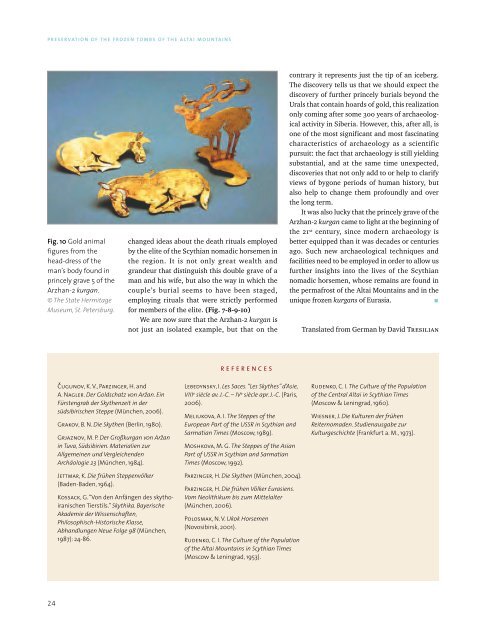Scythian Culture - Preservation of The Frozen Tombs of The Altai Mountains (UNESCO)
Create successful ePaper yourself
Turn your PDF publications into a flip-book with our unique Google optimized e-Paper software.
PRESERVATION OF THE FROZEN TOMBS OF THE ALTAI MOUNTAINS<br />
Fig. 10 Gold animal<br />
figures from the<br />
head-dress <strong>of</strong> the<br />
man’s body found in<br />
princely grave 5 <strong>of</strong> the<br />
Arzhan-2 kurgan.<br />
© <strong>The</strong> State Hermitage<br />
Museum, St. Petersburg.<br />
changed ideas about the death rituals employed<br />
by the elite <strong>of</strong> the <strong>Scythian</strong> nomadic horsemen in<br />
the region. It is not only great wealth and<br />
grandeur that distinguish this double grave <strong>of</strong> a<br />
man and his wife, but also the way in which the<br />
couple’s burial seems to have been staged,<br />
employing rituals that were strictly performed<br />
for members <strong>of</strong> the elite. (Fig. 7-8-9-10)<br />
We are now sure that the Arzhan-2 kurgan is<br />
not just an isolated example, but that on the<br />
contrary it represents just the tip <strong>of</strong> an iceberg.<br />
<strong>The</strong> discovery tells us that we should expect the<br />
discovery <strong>of</strong> further princely burials beyond the<br />
Urals that contain hoards <strong>of</strong> gold, this realization<br />
only coming after some 300 years <strong>of</strong> archaeological<br />
activity in Siberia. However, this, after all, is<br />
one <strong>of</strong> the most significant and most fascinating<br />
characteristics <strong>of</strong> archaeology as a scientific<br />
pursuit: the fact that archaeology is still yielding<br />
substantial, and at the same time unexpected,<br />
discoveries that not only add to or help to clarify<br />
views <strong>of</strong> bygone periods <strong>of</strong> human history, but<br />
also help to change them pr<strong>of</strong>oundly and over<br />
the long term.<br />
It was also lucky that the princely grave <strong>of</strong> the<br />
Arzhan-2 kurgan came to light at the beginning <strong>of</strong><br />
the 21 st century, since modern archaeology is<br />
better equipped than it was decades or centuries<br />
ago. Such new archaeological techniques and<br />
facilities need to be employed in order to allow us<br />
further insights into the lives <strong>of</strong> the <strong>Scythian</strong><br />
nomadic horsemen, whose remains are found in<br />
the permafrost <strong>of</strong> the <strong>Altai</strong> <strong>Mountains</strong> and in the<br />
unique frozen kurgans <strong>of</strong> Eurasia.<br />
Translated from German by David Tresilian<br />
R EFERENCES<br />
v<br />
Cugunov, K. V., Parzinger, H. and<br />
v<br />
A. Nagler. Der Goldschatz von Arzan. Ein<br />
Fürstengrab der Skythenzeit in der<br />
südsibirischen Steppe (München, 2006).<br />
Grakov,B.N.Die Skythen (Berlin, 1980).<br />
v<br />
Grjaznov,M.P.Der Großkurgan von Arzan<br />
in Tuva, Südsibirien. Materialien zur<br />
Allgemeinen und Vergleichenden<br />
Archäologie 23 (München, 1984).<br />
Jettmar,K.Die frühen Steppenvölker<br />
(Baden-Baden, 1964).<br />
Kossack, G.“Von den Anfängen des skythoiranischen<br />
Tierstils.” Skythika. Bayerische<br />
Akademie der Wissenschaften,<br />
Philosophisch-Historische Klasse,<br />
Abhandlungen Neue Folge 98 (München,<br />
1987): 24-86.<br />
Lebedynsky, I. Les Saces.“Les Skythes” d’Asie,<br />
VIII e siècle av. J.-C. – IV e siècle apr. J.-C. (Paris,<br />
2006).<br />
Meliukova, A. I. <strong>The</strong> Steppes <strong>of</strong> the<br />
European Part <strong>of</strong> the USSR in <strong>Scythian</strong> and<br />
Sarmatian Times (Moscow, 1989).<br />
Moshkova, M. G. <strong>The</strong> Steppes <strong>of</strong> the Asian<br />
Part <strong>of</strong> USSR in <strong>Scythian</strong> and Sarmatian<br />
Times (Moscow, 1992).<br />
Parzinger,H.Die Skythen (München, 2004).<br />
Parzinger, H. Die frühen Völker Eurasiens.<br />
Vom Neolithikum bis zum Mittelalter<br />
(München, 2006).<br />
Polosmak, N. V. Ukok Horsemen<br />
(Novosibirsk, 2001).<br />
Rudenko, C. I. <strong>The</strong> <strong>Culture</strong> <strong>of</strong> the Population<br />
<strong>of</strong> the <strong>Altai</strong> <strong>Mountains</strong> in <strong>Scythian</strong> Times<br />
(Moscow & Leningrad, 1953).<br />
Rudenko, C. I. <strong>The</strong> <strong>Culture</strong> <strong>of</strong> the Population<br />
<strong>of</strong> the Central <strong>Altai</strong> in <strong>Scythian</strong> Times<br />
(Moscow & Leningrad, 1960).<br />
Wiesner,J.Die Kulturen der frühen<br />
Reiternomaden. Studienausgabe zur<br />
Kulturgeschichte (Frankfurt a. M., 1973).<br />
24
















